

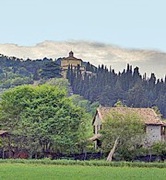
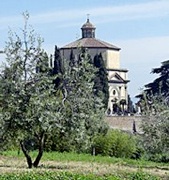
Pope Gregory IX established a nunnery of Poor Clares here in 1225-32 with the support of Bishop Ranieri. Gregory IX exempted the nuns from the episcopal jurisdiction in 1235, and they were placed under the spiritual guidance of local Franciscans in 1246.
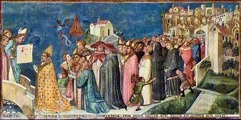
The nuns’ church was dedicated as San Lorenzo in Vineis, a reference to its location among vineyards. A fresco (ca. 1364) in the Cappella del Corporale in the Duomo depicts this original church to the right of the bridge over the Rio Chiaro.
In 1354, Giovanni di Vico established a garrison of some 250 soldiers here to protect his stronghold in Orvieto. Papal forces led by Giordano Orsini and supported by the Monaldeschi drove them out and they fled back into Orvieto. A garrison of 150 papal troops that then occupied the nunnery fought off another attack by Giovanni di Vico. The complex was badly damaged by these events, during which the nuns took refuge in Orvieto, probably at San Lodovico and Santa Chiara. Bishop Francesco Monaldeschi moved them permanently to these more secure nunneries in 1436.
The Commune commissioned Raffaello da Montelupo to build the present church and adjacent convent, which became the home of a male Franciscan community. Ippolito Scalza worked continually on the structure in the following years, addressing its chronic instability.
The church was once more in ruins in 1667, when Monaldo Monaldeschi della Cervara paid for its restoration for a reformed male Franciscan community. A further restoration is documented in 1765. The friars also built the small church of Sant' Anna in the city in 1779.
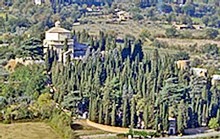
Virginio Vespignani designed the new cemetery that was established here after the unification of Italy in 1860. Massimiliano Fuksas built the zigzag retaining wall around the extended area in 1984. Unfortunately, the church is now closed and in a bad state of repair.
Interior
Madonna and Child (14th century)
This detached fresco, which now forms the altarpiece of the high altar, was originally in the cloister of the nunnery. Its discovery in the ruins in the 1550s, and the subsequent reports of miracles it performed, led to the decision to rebuild the church.
Art From the Church
Crucifix (13th century)
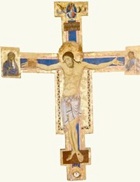
Tabernacle (early 17th century)
This wooden tabernacle, which is now the Museo del Opera del Duomo, is by a follower of Ippolito Scalza. It was probably based on the tabernacle (now lost) by Ippolito Scalza in the Duomo.

